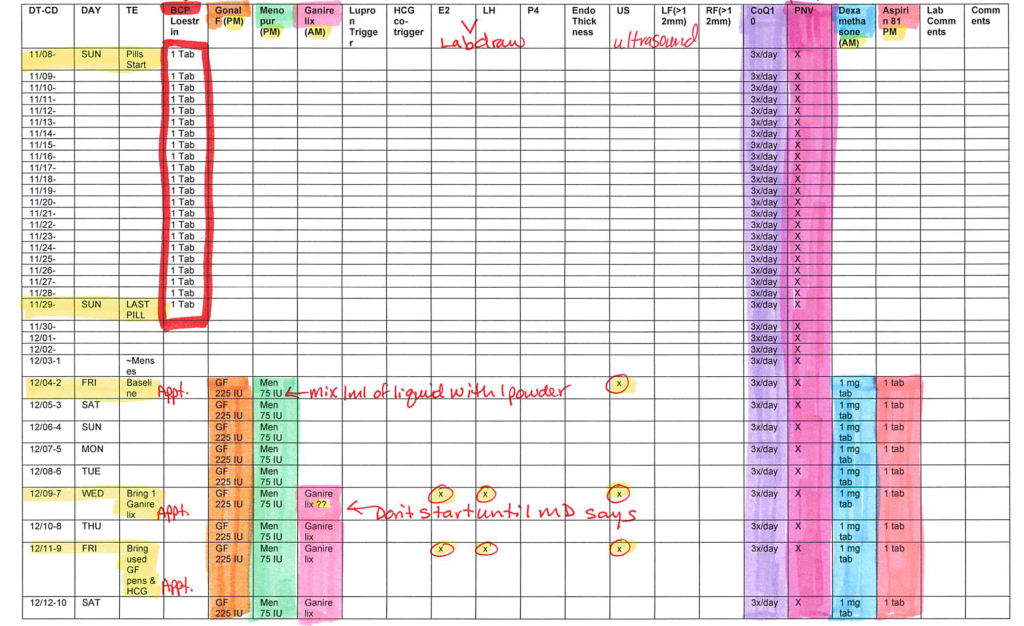- (In)Fertility Journey- 9. IVF Considerations
- (In)Fertility Journey- 8. IVF After Egg Retrieval
- (In)Fertility Journey- 7. IVF Egg Retrieval
- (In)Fertility Journey- 6. IVF Stimulation
- (In)Fertility Journey- 5. Decisions regarding IVF
- (In)Fertility Journey- 4. Preparing for IVF
- (In)Fertility Journey- 3. Before IVF- Hope
- (In)fertility Journey- 2. Background
- In(Fertility) Journey- 1. Introduction

When I first started on this journey, I didn’t know how long it took to get IVF. In our area, there were 3 clinics within a 20 minute drive and no other clinic within an hour drive. It is actually very helpful to have a clinic within an easy drive; chances are you’ll need to keep very closely timed appointments, and the farther it is away, the more complicated the planning. We looked at the information on SART.org, and went ahead with the clinic that had better numbers. We also looked at Yelp.com, to read the reviews.
When I mentioned that it takes a while to get IVF, let me describe the process.
First, you schedule an initial consult, that typically involves a transvaginal ultrasound along with a sit down with the doctor. We called the clinic sometime in August, and the earliest appointment was in mid September. It would be at the end of September if I wanted to speak to a female doctor, so we took the earlier appointment.
Second, after the initial appointment, you have to catch up on a variety of tests. This is called the ‘Precycle Testing‘ period at our clinic. Some of these tests might need to be scheduled or at a certain point in your cycle. You may already have some test results on hand from a different provider if you already did some fertility treatments previously, which means you’ll have to get consents and have the results transferred. Some of the test(s) might need to be repeated if they were over 6 months ago. In our case, because I reported years of painful periods, the doctor recommended, in addition to the standard tests, a ReceptivaDX test for both the markers for endometriosis (BCL6) and endometritis (CD138). Also, because my husband and I wanted to do everything we could before starting IVF, we also did Myriad’s Foresight Carrier Screen-Universal Panel for genetic disorders. I’ll go over these tests at the end of the post.
Third, after all the tests have been performed and we’ve gotten clearance from the patient coordinator, I was given a prescription for both birth control pills as well as for all the drugs necessary for the IVF cycle. This is called the ‘Prep Month‘ at our clinic. In my case, I was prescribed 22 days of Junel Fe 1/20 20mcg-1mg tablet. I was to begin the birth control pills shortly after the start of my period that month. The purpose of the birth control is to establish a baseline, so that upon stimulation, all the follicles would be at the same place, and that all activity in the ovaries and uterus is quiet (or so I was told), the other practical reason for birth control is so that the scheduling for the subsequent ovarian stimulation and egg retrieval can be worked out ahead of time for the greatest convenience. For me, this is why I was prescribed 22 days of birth control instead of just the 21 pills (a single packet of birthcontrol is typically 21 active pills and 7 placebo pills for a total of a 28 day cycle). When I asked about why I’m taking more than a single packet of pills, I was told that birth control is typically prescribed anywhere from 18 to 35 days (?!). Apparently it varies a lot.
Because we are in California, and IVF is not covered in California, this was also the time that we had to pay for the upcoming IVF cycle and all the drugs. The drugs can cost anywhere from $3500 to $8000 for one cycle. These are prescription drugs, not including the over-the-counter prenatal vitamins and supplements that are also recommended. You would definitely want to buy these drugs at the most economical cost. We ended up going with Freedom Fertility Pharmacy, which is based out of Massachusetts, and it took a couple of days to place the order. The order is sent next day via FedEx, and requires a signature.
Note: it was somewhat difficult at times to get a hold of someone at Freedom Fertility Pharmacy, they have no online support, you have to just call during business hours, but once you get through, they are very kind and helpful. Also, something I wished I had done when I placed my order, was to ask for an extra set or two of syringes, needles, alcohol wipes and gauze pads. They include exactly the necessary amount of these and no more, and as someone who was new to this, not having a few extras on hand in case I made a mistake was a source of stress. I would have gladly paid a bit extra to have more wiggle room on these materials. Make sure to account for the necessary amount of all materials after your order arrives. As a side note, the same package of syringes and needles might be intended to be used for more than one medication- the 3ml syringe and 27G 1/2″ needles in my order were intended for administration of Menopur and Novarel.



This was my planned schedule and I ended up following it pretty closely- more details on the stimulation in later post. I was also asked to set up all the appointment day/times at this point.
The pharmacy breakdown as of late 2020 is as follows:
- Gonal-f RFF Pen 450 IUI, Quantity= 5, Price: $2035.65
- Menopur 75 IUI, Quantity= 10, Price: $769.00
- Ganirelix 250mcg/0.5ml, Quantity= 6, Price: $509.40
- Dexamethasone 1mg tab, Quantity= 15, Price: $4.46
- Leuprolide 1mcg/0.2ml Trigger kit, Quantity= 1, Price: $99.90
- Novarel 5000U, Quantity= 1, Price: $79.90
The hope was that this was all I needed and that this would work on the first try. Looking at all the drugs and syringes and needles was really scary. And I was at the lower end of the range of possible drugs! All the drugs with the exception of the dexamethasone are administered via subcutaneous injections in the abdomen. I looked over the instructions for each of the meds several times during the prep month so that I would be familiar (http://freedommedteach.com/eng/).
Just FYI, some of these drugs require you to mix up the solution yourself, or dial the correct dose, so having a familiarity in advance might be helpful. Another thing to note, the packaging for the Novarel stated ‘For intramuscular use only’ but I was directed to subcutaneous injection. It’s a good idea to clarify the prescribed administration of the trigger shots before, as these shots are very time sensitive.
Keep in mind that the storage conditions for the drugs differ, make sure to clarify with your clinic what needs to be refrigerated and what can be kept at room temperature.
We were also prescribed a number of supplements:
- Prenatal Vitamins
- Vitamin D
- CoQ10
- Aspirin 81mg

During the prep month, we also signed a bunch of consents to proceed with the IVF cycle.
Then, we needed to wait for my period to start, the beginning of new cycle to actually start the IVF stimulation for egg retrieval.
Fourth, after the start of my period, this begins what my clinic calls the ‘Stimulation and retrieval‘ month, which, if all goes well, would result in 5-day grown blastocysts that can be transferred. More on this later.
Fifth, after the cycle during which follicle stimulation and egg retrieval took place, because we chose to do Preimplantation Genetics Testing (PGT) screen, and embryo implantation has greater chances of success if performed separately from stimulation and retrieval, we decided to freeze any embryos that resulted from 5 days of culture and PGT screening. So following the stimulation and retrieval cycle, we’d take a rest cycle.
Sixth, or lastly, if there are good embryos that resulted from the stimulation/retrieval cycle, this would be the earliest month/cycle that a frozen embryo could be transferred into the uterus for implantation.
So you see, at least for someone starting out, the whole planned schedule takes about 6 months for the first time for us. And during this time, you could be just following the schedule and checking the boxes. Or me, during which I’m following the schedule, checking the boxes, doing a lot of online research to understand what we’re doing and why, and worrying about everything. And this is where I begin to run into issues of making decisions without knowing all the information and wishing I was better prepared to make better decisions for ourselves. I’ll go over all these in the next post.

Precycle Tests: Myriad Foresight Carrier Screen and ReceptivaDX
As mentioned above as part of the Pre-cycle testing, my husband and I both got a Myriad Foresight Carrier Screen-Universal panel and I had a ReceptivaDX analysis.
The Myriad panel looked to see whether a person is a carrier of various genetic conditions, while the ReceptivaDX looks for indications of endometriosis, and optionally, endometritis. Because of my years of painful periods, my provider suspected endometriosis.
Regarding the Myriad Foresight Carrier Screen, it is a simple blood test. I had already completed some genetic testing prior to this for cystic fibrosis and spinal muscular atrophy, but since we were looking at IVF, it made sense to us to have more information. The ‘Universal Panel’ looked at 176 genes associated with serious and prevalent inherited conditions (list can be found here). Our provider’s opinion is that there was a 15% chance that one of us would have a positive result for a genetic defect, which would necessitate the other partner to get tested, so we both took the test. It cost $199/each, and the result indicated that neither of us were carriers of any of the 176 genetic defects tested.
Regarding the ReceptivaDX test, it required an endometrial biopsy/”scratch” at the fertility clinic and was a painful procedure. Basically, a speculum is inserted into your vagina, and then a plastic tube is inserted through the cervix into the uterus, and in my case, guided by ultrasound. Then, the tube is inserted all the way until it hit the top of my uterus, where my provider then “scratched” at my endometrial lining for about a minute with the tube on suction to get a biopsy sample. The scratching was intensely painful.
Below, I’ll be quoting some references in blue, and include the citation in gray. There’s a lot of additional information you can find, but I’ll just include a minimal explanation here.
The ReceptivaDX test automatically tests for BCL6. “BCL6 is a gene repressor that is regulated by progesterone in the endometrium but dramatically over-expressed in conditions associated with systemic inflammation such as endometriosis.” (Evans-Hoeker E, Lessey BA, Jeong JW, Savaris RF, Palomino WA, Yuan L, Schammel DP, Young SL. Endometrial BCL6 overexpression in eutopic endometrium of women with endometriosis. Reprod Sci. 2016;23:1234–1241. doi: 10.1177/1933719116649711.) In short, an increased expression of BCL6 can be an indicator of endometriosis. This portion cost $690.
In addition, the ReceptivaDX test may include a test for CD138. “The diagnosis of Chronic Endometritis (CE) is based on the detection of abnormal plasma cell infiltration in the endometrial stroma (Greenwood SM, Moran JJ. Chronic endometritis: morphologic and clinical observations. Obstet Gynecol. 1981;58(2):176–184.) “The transmembrane heparin sulfate proteoglycan syndecan-1 (CD138) is a syndecan, which is a specific marker of plasma cells.” (Chen, Yu-Qing et al. “Analysis of the diagnostic value of CD138 for chronic endometritis, the risk factors for the pathogenesis of chronic endometritis and the effect of chronic endometritis on pregnancy: a cohort study.” BMC women’s health vol. 16,1 60. 5 Sep. 2016, doi:10.1186/s12905-016-0341-3) “CD138 immunohistochemistry is used for the detection of chronic endometritis” (Bayer-Garner IB, Nickell JA, Korourian S. Routine syndecan-1 immunohistochemistry aids in the diagnosis of chronic endometritis. Arch Pathol Lab Med. 2004;128(9):1000–1003.) There are some studies that find a positive association between endometriosis and endometritis. In short, a positive detection of CD138 can be an indicator of endometritis. Perhaps this is why my provider included this, I don’t know, he didn’t explain. This add-on cost $125.
ReceptivaDX has an additional option of testing for Beta3 Integrin. “Abnormal endometrial integrin expression was a frequent finding in women with unexplained infertility. These data suggest that defective uterine receptivity may be an unrecognized cause of infertility in this population of women.” ( Lessey BA, Castelbaum AJ, Sawin SW, Sun J. Integrins as markers of uterine receptivity in women with primary unexplained infertility. Fertil Steril. 1995 Mar;63(3):535-42. PMID: 7851583.) If this test is ordered, the timing of the ReceptivaDX test is important, and depends on whether you are on your natural cycle or on a treatment cycle. My provider did not order this, so my biopsy could be scheduled anytime outside of my period. I don’t know why my provider did not order this test. As I mentioned previously, the course of my IVF preparation and cycle was determined by my provider on our first consult, and we never met in person for another consult. I didn’t know anything about this test at the time. This additional test costs $125 extra.
The results of my ReceptivaDX test was that my BCL6 was not elevated, but my CD138 was positive; this suggested I had endometritis.
Endometritis is basically an inflammation of the endometrial lining inside the uterus, often caused by bacterial infection, sometimes the cause is unclear. There also seems to be two types of endometritis, acute and chronic. Because the only symptom I have is painful period, for years, I’m in the chronic endometritis (CE) group. There is a correlation between CE and failure of embryo to implant in the uterus during IVF. A number of studies suggest that antibiotic treatment has a high probability of ‘curing’ CE, and women with CE who are treated with antibiotics and cleared their CE have a higher probability of successful embryo implantation during IVF. Here is a paper by Kimura et. al, that discusses the current research findings on CE and its effect on reproduction. In short, there are lots of variability in antibiotic treatments (type, dose, length, single/multiple treatment, etc.). This is another area of female reproductive health for which much is unknown.
Due to my results, my provider suggested antibiotic treatment during implantation. After some research and discussion with my husband, my provider agreed to treat us both with antibiotics right after my egg retrieval. This would allow an opportunity to do another endometrial biopsy and ReceptivaDX test to check whether the antibiotic treatment successfully eliminated the inflammation in my endometrial lining before doing an embryo transfer. The assumption is that endometritis has no effect on my ovaries or the IVF egg retrieval process.
